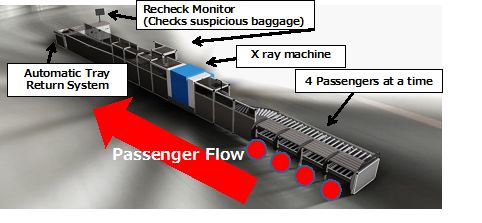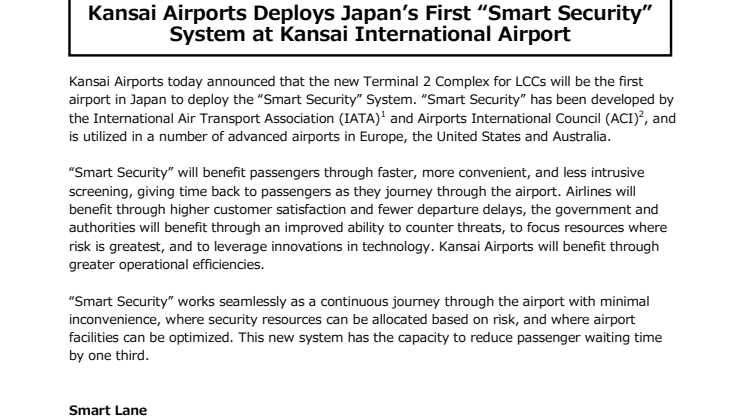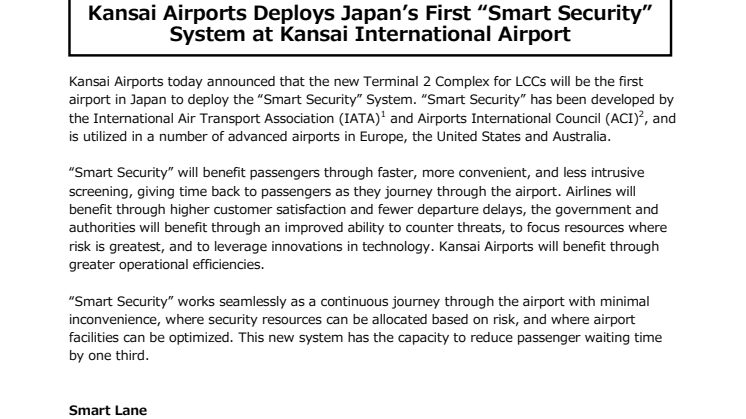Press release -
Kansai Airports Deploys Japan’s First “Smart Security” System at Kansai International Airport
Kansai Airports today announced that the new Terminal 2 Complex for LCCs will be the first airport in Japan to deploy the “Smart Security” System. “Smart Security” has been developed by the International Air Transport Association (IATA)[1] and Airports International Council (ACI)[2], and is utilized in a number of advanced airports in Europe, the United States and Australia.
“Smart Security” will benefit passengers through faster, more convenient, and less intrusive screening, giving time back to passengers as they journey through the airport. Airlines will benefit through higher customer satisfaction and fewer departure delays, the government and authorities will benefit through an improved ability to counter threats, to focus resources where risk is greatest, and to leverage innovations in technology. Kansai Airports will benefit through greater operational efficiencies.
“Smart Security” works seamlessly as a continuous journey through the airport with minimal inconvenience, where security resources can be allocated based on risk, and where airport facilities can be optimized. This new system has the capacity to reduce passenger waiting time by one third.
Smart Lane
The smart lanes will speed up cabin baggage screening by moving trays automatically, reducing the need for both passengers and airport workers to move trays. Passengers will progress through security in the smart lanes, and will be screened by body scanners and WTMDs.
Moreover, a typical security lane in airports in Japan is 7 meters long, the Smart Lane will be 17 meters, allowing multiple people to use the lane at the same time, as well as allowing plenty of space to take off coats and other garments, as well as space to put items of clothing back on. This again reduces waiting time. Boarding pass checks will be stationed in the queue leading to the security lanes, rather than just before the security machine when the passenger is busy coping with luggage.
These lanes will have the capacity for 300 passengers per hour, a significant increase on the current 180.
Body scanners
Currently airport security screening processes for passengers and hand luggage are focused primarily on the detection of metallic threats, using walk-through metal detectors (WTMDs), supplemented by manual pat-downs. Under “Smart Security”, the latest model body scanner is added to the system. The body scanners can be used for those who set off the WTMD alarm, or who are selected for additional screening, allowing for a less intrusive and faster screening process than manual pat-downs, which can reduce passenger stress.
In-line luggage security check
Check-in luggage security searches will be moved to an in-line process. The conveyor belt system first takes the luggage from check-in to an X-Ray machine that checks its content, and then orients the luggage to the aircraft. Current systems involve passengers bringing their luggage by themselves to an X-Ray in the check in area, before the luggage is sent to the plane.
[1] IATA (International Air Transport Association) represents some 240 airlines comprising 84% of global air traffic.
[2] ACI is the only global trade representative of the world’s airports. Established in 1991, ACI represents airports’ interests with governments and international organizations, develops standards, policies and recommended practices for airports, and provides information and training opportunities to raise standards around the world.
Body Scanner:

Diagram of Smart Lane

Related links
Topics
- Business enterprise
Categories
- kix
- smart lane
- body scanner
- international
- security
- airline
- airport
- osaka
- kansai
- japan
About Kansai Airports
As of April 1, 2016, Kansai Airports succeeded the right of operating Kansai International Airport (“KIX”) and Osaka International Airport (“ITM”) from New Kansai International Airport Company (“NKIAC”) and commenced its business as an operating company for the two airports. Kansai Airports was established by a consortium made up of VINCI Airports and ORIX Corporation as its core members.
Kansai Airports shares the common goal of maximizing the potential of the Kansai International Airport and Osaka International Airport, improving services to passengers and give the highest priority of safety and security, investment to enhance safety, convenience and comfort to increase value, as well as enhancing community relations in the neighborhoods of the airports and benefiting the Kansai regional economy.
For more information, visit http://www.kansai-airports.co.jp/en/index.html


